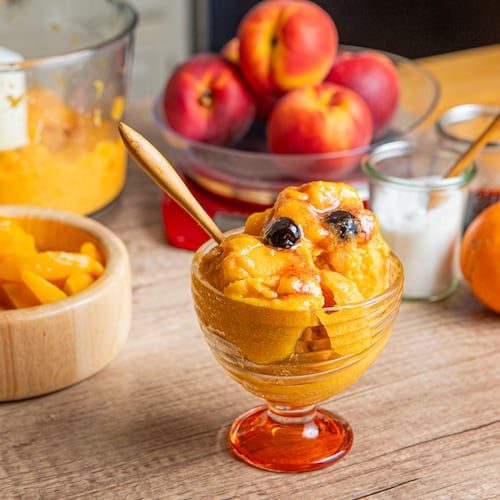If your summer involves a trip to a beach or lake, you can’t help but think about fish when you’re around all that water. And if you’re like me, a stop at the local seafood market is one of your vacation traditions.
Fish is low in calories, offers high-quality protein and cooks quickly on the stovetop or grill. Studies have shown that eating fish regularly lessens the risk of getting heart disease and may help other medical conditions, too.
Still, the average American eats only about 15 pounds of fish a year, and most of that is in restaurants.
Why don’t we eat more fish, and why aren’t we cooking it at home?
Vicky Murphy thinks it’s a lack of confidence when it comes to buying and cooking.
“We’d love more people to cook seafood at home,” said Murphy of Inland Seafood. The company has been processing and distributing fish for more than 30 years, providing the seafood for more than 3,500 restaurants and 900 retail outlets in the Southeast.
“The main reason more than two-thirds of all seafood is consumed in restaurants is that home cooks aren’t comfortable buying seafood. And then when they build up the nerve to purchase it, they often overcook it. Since most seafood products are an expensive form of protein, if a consumer overcooks their seafood, they are turned off by a bad experience,” Murphy said.
How to buy seafood
Vicky Murphy said there are two simple steps in buying seafood: Smell it and look at it.
Fresh fish smells like seawater or cucumber. If it has a strong, objectionable odor, it’s past its prime.
Fin fish should have firm, elastic flesh. Any exposed flesh should appear freshly cut without traces of browning or drying out. If the fish has scales, they should adhere closely to the skin and should not be dry or “ruffled” looking
Plan to use fresh fish within two days of purchase. Fresh fish will keep best loosely wrapped and packed in finely crushed ice. Once the fish is cooked, it will keep for another two or three days.
If you’re buying frozen fish, check the package for ice crystals. That can be a sign the fish has been thawed and refrozen. White, dehydrated areas are a sign of freezer burn.
Never thaw fish at room temperature, and never refreeze. Thaw frozen fish in the refrigerator, allowing 18 to 24 hours per pound to thaw. If you need it more quickly, thaw fish under cold, running water.
Fresh shrimp should have a firm texture and mild odor. Fresh shrimp will keep in the refrigerator for two to three days. If buying frozen shrimp, check the same signs as for frozen fish.
Scallops should be creamy white, light tan or pinkish and have a mild, slightly sweet odor. Store them on ice in the refrigerator and they should keep two to three days.
Fresh hard-shelled crabs are sold alive, cooked or as fresh or pasteurized cooked meat. If purchased live, make sure the crabs are still moving and cook them the same day.
Fresh or pasteurized crab meat has a very mild odor and should be used within one to two days of purchase. Crab will maintain quality better if packed in ice in the refrigerator.
Clams and mussels should be alive when sold. It’s easy to tell if they’re alive because they will either have their shells closed or if they are gaping open, a quick tap will prompt them to tightly close. At home, store clams dry and uncovered in the refrigerator, in a pot or bowl; store mussels packed in ice. Never store clams or mussels in a plastic bag; they’ll suffocate.
Oysters are sold shucked or in the shell. Shucked oysters should be plump, with a natural creamy color and clear liquid. If handled properly, they’ll maintain quality for about a week. Oysters in the shell must be alive, with their shells tightly closed. Store them in the refrigerator, un-iced, for up to 10 days.
Safely cooking seafood
The great thing about cooking fish and shellfish is that they offer visual clues that let you know they’re done. The flesh of fish, shrimp or scallops will become firm and change from translucent to opaque. Resist the old advice to cook fish until it flakes — by then it is often too well done.
“I encourage consumers to aim at slightly undercooking seafood. Due to the fact it is a very tender source of protein, it will continue to cook when taken from the source of heat,” Vicky Murphy said.
A common mistake is overcooking shrimp. The easiest way to cook shrimp is to bring seasoned water to a boil, add the shrimp, then cover the pot and turn off the heat. Depending on the size and quantity, the shrimp will be fully cooked in three to five minutes.
For clams, mussels and oysters, they’re done when their shells pop open. Discard any that stay closed.
Consumers also might be worried about seafood coming from the Gulf of Mexico after the ongoing oil spill.
The National Fisheries Institute says seafood from the Gulf is safe.
“The waters where the oil is are closed to fishing and officials have tested thousands of samples from the rest of the Gulf and found no contamination, and there’s more testing going on right now than ever before,” said spokesman Gavin Gibbons.
Only about 2 percent of seafood we eat in the U.S. comes from the Gulf, Gibbons said.
“We get fish from all over the country and even the world, so there should be plenty of fish to go around. But Gulf fishermen have been hit hard by this and one way to help them is to buy Gulf seafood; it remains safe, healthy and delicious,” he said.
--------------------
Grilled Fish Kebabs in Lettuce Wraps
Hands on: 15 minutes Total time: 15 minutes Serves: 4
It’s hard to believe a recipe that goes together this quickly can pack so much flavor. Be sure to use a firm fish that will hold together on skewers. You could substitute sea scallops for the fish, being sure not to overcook.
1/4 cup olive oil
2 tablespoons chopped fresh oregano, marjoram or parsley
2 cloves garlic
1/2 teaspoon salt
1/2 teaspoon pepper
Juice of 1 lemon
1 pound tuna or salmon, cut into 1-inch chunks
4 metal or soaked bamboo skewers
Vegetable oil
12 large leaves of bibb or red leaf lettuce
1 lemon, cut into 4 wedges
1 avocado, peeled, pitted, sliced
Preheat grill.
In a food processor, combine olive oil, herbs, garlic, salt, pepper and lemon juice, and pulse until the mixture makes a smooth paste.
In a medium bowl, rub fish chunks with paste. Thread chunks onto skewers.
Brush grill grates with oil. Grill skewers, turning as needed, 5 minutes or until fish is firm and slightly blackened. Remove chunks from skewers and divide among lettuce leaves. Serve with lemon wedges and avocado slices.
Adapted from Bon Appétit, May 2008
Per serving: 320 calories (percent of calories from fat, 64), 27 grams protein, 2 grams carbohydrates, trace fiber, 22 grams fat (4 grams saturated), 43 milligrams cholesterol, 311 milligrams sodium.
--------------------
Crab Cake Burgers
Hands on: 10 minutes Total time: 20 minutes Serves: 4
These crab cakes have just enough filler to hold the crab meat together. Eliminate the mustard to cut the sodium content. If crab isn’t in your budget, substitute chopped cooked shrimp.
1 egg
2 tablespoons chopped fresh parsley
1 teaspoon Old Bay seasoning
1 teaspoon Worcestershire sauce
1 tablespoon Dijon mustard
1 1/2 tablespoons mayonnaise
1 pound lump crab meat, picked over to remove shell and cartilage
1/4 cup fresh bread crumbs (made from 1 slice bread)
1 tablespoon vegetable oil
4 sandwich rolls
4 leaves lettuce
4 slices tomato
In a medium bowl, beat egg with parsley, Old Bay, Worcestershire, mustard and mayonnaise. Add crab and bread crumbs and fold everything together by hand. Be careful not to over mix. Form 4 cakes, handling the mixture as little as possible. Cakes can be made up to one day ahead, covered and refrigerated.
In a large skillet, heat oil over medium-high heat until it just starts to shimmer. Cook the patties until outside is golden and interior is hot, about 5 minutes per side, turning once. Serve on rolls with lettuce and tomato.
Adapted from “Roadfood Sandwiches: Recipes and Lore From Our Favorite Shops Coast to Coast” by Jane and Michael Stern (Houghton Mifflin, $14.95)
Per serving: 396 calories (percent of calories from fat, 30), 30 grams protein, 39 grams carbohydrates, 2 grams fiber, 13 grams fat (2 grams saturated), 143 milligrams cholesterol, 851 milligrams sodium.
--------------------
Fish Tacos
Hands on: 20 minutes Total time: 20 minutes Serves: 4
Fish tacos are often filled with fried fish. Here, the fish is sautéed, making it lighter, and the crunch comes from the cabbage shreds. Don’t overcook the fish; sauté just until opaque. Try this same recipe with shrimp, or splurge on crab or scallops.
1 tablespoon olive oil
1/2 cup chopped red onion
1 pound mild white fish, such as mahi mahi, tilapia or bass
1 teaspoon ground cumin
1/2 teaspoon salt
1/4 teaspoon pepper
Juice of 1 lime
8 (6-inch) corn tortillas, warmed
2 cups shredded cabbage
2 cups chopped fresh tomato
Hot sauce, to taste
Sour cream, for garnish
In a medium skillet, heat olive oil over medium heat and sauté chopped onion until soft, about 3 minutes. Transfer onions to a small bowl and set aside.
In the same skillet, begin sautéing fish. As fish cooks, break it into chunks and add cumin, salt and pepper. Cook until fish is just opaque. Remove from heat, pour lime juice over fish and taste for seasoning. Be sure to scrape up the browned bits in the bottom of the pan.
Divide fish and onions among 8 corn tortillas filled with cabbage and tomato. Garnish to taste with hot sauce and sour cream.
Adapted from “Mark Bittman’s Kitchen Express” (Simon & Schuster, $26)
Per 2-taco serving: 296 calories (percent of calories from fat, 27), 25 grams protein, 29 grams carbohydrates, 4 grams fiber, 9 grams fat (2 grams saturated), 77 milligrams cholesterol, 435 milligrams sodium.
About the Author
The Latest
Featured

